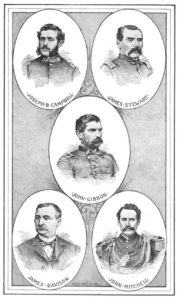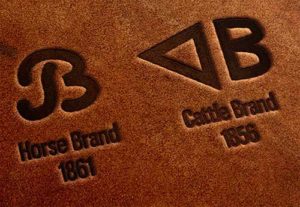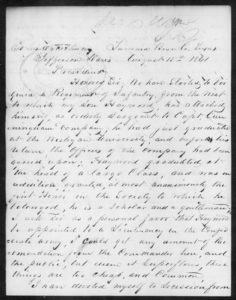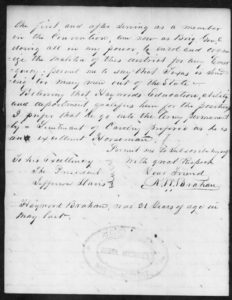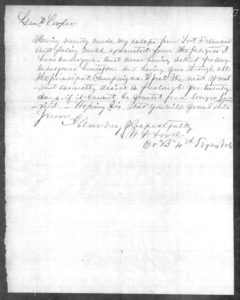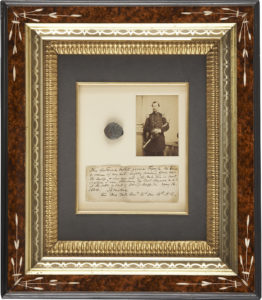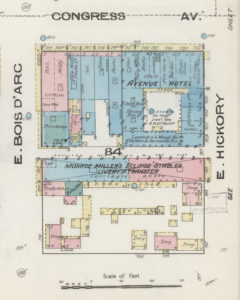The Battle Leaders of the Battery.
13 March 2022
From the frontpiece of Augustus C Buell’s The Cannoneer: Recollections of Service in the Army of the Potomac (1890), here are some of the officers of Battery B, 4th United States Artillery before and during the war. Etchings after photographs.
Captain Campbell commanded the battery at Antietam until wounded, succeeded by Lieutenant Stewart. Brigadier General Gibbon, a career Regular Artillery officer, was Captain of Battery B at the start of the war; he led the Brigade and helped man a gun of Battery B at Antietam. Lieutenant Davison of the 3rd US Artillery joined the battery after Antietam and commanded a “half-battery” of “B” at Gettysburg until he was wounded and replaced by then-Lieutenant Mitchell. Mitchell was First Sergeant of the Battery at Antietam and cited for bravery there. He is pictured here in his post-war uniform as a Captain in the 43rd (later 1st) US Infantry.
Augustus Caesar Buell (1847-1904) is now generally known as a “fraud historian” – particularly because of his biographies: Paul Jones, Founder of the American Navy (1900), Sir William Johnson (1903), William Penn as the Founder of Two Commonwealths (1904), and History of Andrew Jackson, Pioneer, Patriot, Soldier, Politician, President (1904) – all apparently at least plagiarized if not entirely made-up.
He wrote much of Cannoneer as if he was an eyewitness to it all, when he hadn’t actually enlisted in the 20th New York Cavalry until August 1863 and was (probably) detailed to the battery some time later. Although it must be viewed skeptically, the book is an excellent source of detailed information about Battery B/4th US Artillery.
It owes its value to the many soldiers and officers of the battery who contributed to its content, notably Captain Stewart, Sergeant C.A. Santmyer, and Private B.H. Stillman, who had been detailed from the 7th Wisconsin Infantry.
R W Brahan to President Jefferson Davis (15 Aug 1861)
29 December 2021
Robert Weakley Brahan was born into a prominent Nashville, TN family in 1811, trained as a physician, married well, and had all the right friends, among them, apparently, President Andrew Jackson. After a decade in Panola County, MS, he took his family to Bexar County, TX in 1852 and established a large plantation and raised cattle there.
In July 1861 his oldest surviving son Haywood Weakley Brahan, 21, enlisted as First Sergeant of Company F, 4th Texas Infantry and started off for New Orleans to get a train to Virginia.
Shortly afterward, in August, Robert sent a letter to President Jefferson Davis requesting a commission for his son. He asked as a “personal favor” and cited Harwood’s excellent college record, “ability, and deportment,” as well as his own work as a Brigadier General of Texas Militia on the homefront. He added “I prefer that he go into the Army permanently = Lieutenant of Cavalry preferred as he is an excellent horseman.”
I expect the President got hundreds if not thousands of such letters. Like most of them, he probably ignored this one, as a commission was not immediately forthcoming.
Young Haywood was elected 2nd Lieutenant of his Company on his own merits (probably) in November 1862 and survived Sharpsburg and all the other actions of the regiment to Appomattox in April 1865.
___________________
Notes
His brands above and much more about Robert W Brahan are from a fine post on Lost Texas Roads by Regina Tolley and Allen Kosub.
The letter pages here are from Haywood’s Compiled Service Records, US National Archives, via the fold3 subscription service.
Fighting them twice at Sharpsburg
19 December 2021
Private William F. Ford of the Tom Green Rifles, Company B, 4th Texas Infantry had an extraordinary war.
At Sharpsburg on 17 September 1862 he and his regiment were part of Hood’s Division’s devastating charge into Miller’s cornfield early that morning. But that wasn’t enough for Ford.
… after the Brigade was relieved about 10 o’clock am, he was sent off and accidentally meeting the 9th Georgia Regt. reported to Capt King of Co “K” and fought with them till night. Capt King gave him a certificate complimenting him for his gallant conduct thro’ the the day, which certificate was endorsed by both the Col commanding the 9th Georgia Regt and Col Anderson – now Brigadier – commanding the Brigade …
He was captured at Gettysburg in July 1863 and sent to the US prison at Fort Delaware. From which he escaped in August or early September. Not an easy thing, as shown by the fate of Hoxey Whiteside, Company G of the 4th Texas, who attempted such an escape a couple of months after Ford, in November 1863, but drowned in the Delaware River.
Private Ford “passed through parts of Delaware, New Jersey, and Maryland in the disguise of a citizen, arriving safely in Richmond” and, not a shy man, made a request for a furlough directly to the CSA’s Adjutant General, General Samuel Cooper – “hoping sir, that you will grant this favor.” Cooper did.
He was commissioned Junior 2nd Lieutenant of his Company on 1 April 1864 “for valor and skill” and distinguished himself in combat again, in the Wilderness of Virginia, where he was wounded in the leg on 6 May 1864. He was promoted to Senior 2nd Lieutenant on 16 June.
In addition to all this, his is the second case [first, here] I’ve found of a Confederate officer applying to raise and command a “negro regiment.”
He made that request on about 12 March 1865 through his military chain of command, and a week later wrote to John H Reagan, the Postmaster General of the Confederate States, asking for help in expediting it.
Reagan forward a positive recommendation to Secretary of War Breckenridge on 22 March. The reply came back the same day (cover below).
Res. ret’d to the Post Master General. The application has not reached us, but the Dept. has decided not to grant authority to recruit larger organizations of col’d troops than companies except where a battalion of four companies can be raised from one estate.
By com’d Sec. War:
[Captain] John W. Riely, AAG
Word got to Lieutenant Ford on 30 March 1865. It was largely a moot point by then, anyway – Federal troops entered Richmond 4 days later.
He was surrendered and paroled at Appomattox Court House, VA on 9 April 1865, and went home to Austin, Texas. He died there in 1875.
Isaac Wistar in 1863, 1853, and 1845
18 December 2021
Colonel Isaac J Wistar commanded the California Regiment (designated the 71st Pennsylvania Infantry) at Antietam and was later commissioned Brigadier General of Volunteers.
Here he is wearing some serious epaulettes.
To compare, here are two pictures of him as a much younger man.
He was halfway in age between the two lower views when he took off across the continent from Philadelphia to find gold in California in 1849. Quite an adventure. He only came back 12 years later because of the war …
_____________________
All three pictures are from his posthumously published Autobiography of Isaac Jones Wistar, 1827-1905 (1914). It’s online [Volume 1 | Volume 2] from the Internet Archives. It’s a pretty good read, actually, especially his diary entries from his 1849 trip to California.
____________________
The interesting Wistar artifact below was sold by Heritage Auctions in 2008. The accompanying photograph is very similar to the one at the top of this post, and was probably taken in the same session
[Bullet that Grazed the Head of Brigadier General Isaac J. Wistar]
From the seller: A mushroomed Confederate minié ball is preserved in a inlaid period frame with a CDV of the general and a 5″ x 2″ Autograph Note Signed, reading as follows:
“This flattened bullet passed through the brim & crown of my hat, slightly drawing blood on the scalp & was dug out of the oak tree in front of which I was standing by Capt. Reynolds A.A.G. at the battle in front of Drewry’s Bluff, Va. May 16, 1864. J I Wistar then Brig Genl’ Commdg 2nd Div. 18th A.C.”
Congress Avenue, Austin, TX (1867)
17 December 2021
A view north down Congress Avenue in Austin, TX just after the war. Try to ignore the tight-rope walker. The (old/2nd) State Capitol building is at the end of the avenue. At right, under the Avenue Hotel sign, is the Swenson Building – the Avenue Hotel took the upper 2 floors, and a number of businesses shared the first floor with storefronts under that awning.
One of those was a grocery and liquor store operated by Sharpsburg veteran and late Private, Company B, 4th Texas Infantry, Thomas E. Cater.
Here’s a plan view of that same city block 20 years later, showing some of those businesses, from the Sanborn Fire Insurance Map (1885), online thanks to the Library of Congress.
A fine businessman I’m sure, but Thomas E Cater caught my eye for another reason.
In February 1863, while serving in Virginia, he got a furlough home to Texas, but he was listed as absent without leave – AWOL – when he hadn’t returned by May. I could find no evidence of a catastrophic wound or dire illness to explain why he left and I don’t know why he didn’t return. Perhaps he preferred being with his new wife and baby daughter Elizabeth in Austin.
But (and here’s the extraordinary part) while still technically an AWOL Private of the 4th Infantry in December 1863 he was assigned to command a Company in or near Austin …
… he was Captain Cater with his own independent cavalry company on 27 December 1863 and by August 1864 he was a Major commanding his and 2 other Companies as Cater’s Battalion of Texas Cavalry. They had service in South Texas to the end of the war, though without Cater in their final action at Palmito Ranch, TX – arguably the last battle of the war.
He was formally surrendered at Galveston, TX on 25 May 1865 and paroled in Austin on 27 July. He went home, established that mercantile establishment, and had many more children.
_______________
The photograph at the top is in the collection of the Austin History Center, Austin Public Library and hosted online by the University of North Texas Libraries. The caption reads:
Scene on Congress Avenue in 1867, showing exhibition by [French] tight-rope walker ([Jean] Devier) across the Avenue from the historic old Avenue Hotel at Eighth and Congress, on East side. The carriage at the left, entering the Avenue, is that of Gov. E. M. Pease (Gov. from 1853-57 and 1867-69).
The card here is from his Compiled Service Record jacket; the original is in the US National Archives.
_______________
My notes on operations and leaders of Cater’s Battalion 1864-1865, after the break …
General James B. Ricketts in Union uniform and his wife, Frances
22 December 2020
This fine Brady portrait photograph of the General and his wife is in the Library of Congress. A career US Army officer, West Point ’39, Brigadier General James B Ricketts commanded the 2nd Division in the First Army Corps at Antietam. He was injured there when his horse fell on him, but remained with his command.
Brigadier General Fitzhugh Lee (nephew of R.E. Lee) commanded a Brigade of Cavalry on the 1862 Maryland Campaign. This carte-de-visite of him is in the collection of the Library of Congress.
Brigadier General Albion P Howe was in command of a Brigade in the Fourth Army Corps in Maryland in 1862. He’s seen toward the left, hand on sword hilt, in this photograph of the members of the Military Commission to Try the Lincoln Assassination Conspirators in May 1865.
The voting members of the Commission were Generals David Hunter, August Kautz, Albion Howe, James Ekin, David Clendenin, Lew Wallace, Robert Foster, and T. M. Harris, and Colonel C. H. Tomkins.
Capt Gilbert J Wright
9 August 2020
Captain “Gib” Wright led Company D of Cobb’s Legion Cavalry Battalion and was wounded in action at Quebec Schoolhouse near Middletown, MD on 13 September 1862. He commanded a brigade by the end of the war and may have been appointed Brigadier General in January 1865. His photograph is in the collection of the Georgia Historical Society, and is online from fold3.
Capt William Covill
16 July 2020
Captain William Covill, Jr of the First Minnesota Infantry was with his Company in action in the West Woods at Antietam on 17 September 1862, and later remembered
As I saw it the whole Division except our Regiment was broken into a mob, madly pressing to the rear followed closely by the enemies lines. Instantly on the breaking up of the 84th [82nd] N.Y. which was next on our left, Col Sully of our Regiment gave the order to about face and march to the rear, which we did double quickly, accompanied with a shower of cannister from a battery which had hurried up the pasture field …
By May 1863 he had been promoted to Colonel of the regiment and was seriously wounded leading them at Gettysburg in July. After mustering out he was elected to the state legislature, in November 1864, but left St. Paul to serve again in the field, as Colonel of the First Minnesota Heavy Artillery from April to July 1865. He was honored with the title of Brevet Brigadier General.
His photograph is in the collection of the US Army Heritage and Education Center in Carlisle, Pennsylvania.
